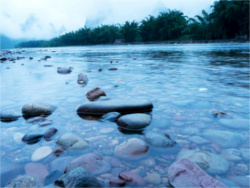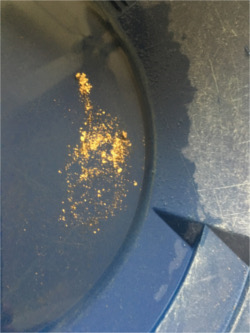Gold Panning - How To
Gold panning is based on the fact that gold is a very dense - very heavy for its size - about 70% denser than lead. Given the chance, it will settle down through lighter sand and pebbles.
- You shovel some paydirt into your gold pan - enough to half or three-quarters fill it.
- You add water to the pan from time to time by gently lowering it into still water in the creek or a tub. You can tilt the pan a bit so water flows in on one side. You don't want water to pick up fine gold and flow out again.
- You wash and remove larger pieces of gravel and clay, and totally break down smaller lumps of clay by hand.
- You shake the pan from time to time, shaking it from side to side slightly to get everything moving. The gold will settle lower in the pan. Fine gold won't settle if the shaking is too rough.
- You shake the pan to settle the gold, and then sweep the material on top out of the pan with your hand. This is how you get most of the material out of the pan.

- If the water gets too dirty, you shake the pan to settle any gold near the top, and then gently pour some water out. You can add more water at any time as described above.
- When there is less material in the pan, you can remove the top material using swirling water. You make it move around in a circle - with the pan tilted a little so that some water and lighter material are swirled out. (You don't have to do this - you can just sweep material off the top with your hand.)
- With less material in the pan, shaking is done with the far side of the pan tipped down so that any gold will settle to the edge of the bottom of the pan.
The Last Little Bit - Black Sand and Gold
When you are down to the last bit of sand in a gold pan, it can be challenging to separate out the gold.Some of the remaining sand in the pan will likely be black. Black sand is made of minerals that are high in iron. It is much heavier than regular sand, but much lighter than gold.
By using a small amount of water and the right swirling motion, you can swirl the lighter sand furthest around the pan, the black sand a little way around, exposing any gold, which moves the least. Nuggets and large enough flakes can be picked up with tweezers.
 When all the gold is along part of the bottom edge with no water,
you can tip the pan steeply with the gold highest. If you
dip the pan into water, anything the water touches will fall out.
When all the gold is along part of the bottom edge with no water,
you can tip the pan steeply with the gold highest. If you
dip the pan into water, anything the water touches will fall out.
Using a Magnet
Some black sand (magnetite) will stick to a magnet. If you use a bare magnet to pick it up, you will never get it all off. However, you can wrap the magnet in plastic - when you remove the magnet, all the black sand can be easily rinsed off.There are devices that do the same sort of thing. They can be used with one hand and don't cost much.
Snuffer Bottles
 Fine gold under a little water in the pan can be picked up with a
snuffer bottle (aka sniffer bottle) - a small plastic bottle that
you use like an eye-dropper. Squeeze the bottle and then slowly
release the pressure to suck up some water and gold.
Fine gold under a little water in the pan can be picked up with a
snuffer bottle (aka sniffer bottle) - a small plastic bottle that
you use like an eye-dropper. Squeeze the bottle and then slowly
release the pressure to suck up some water and gold.
Devices to Process Concentrates
If you are recovering a fair bit of black sand and gold (known as "concentrates"), you may want to look into some of the devices that make it easier to separate the gold from the black sand. You can make a "sluice half-pipe" for about $20. There are also bowls and gold spirals. See Separating Gold from Concentrates on the Mining Equipment page. for more information.Where to Pan for Gold
Which creek or river?
Of course, you want to pan for gold on a gold-bearing creek or river. You might already know that a stream is gold-bearing. If you don't know, you can use a gold pan to find out - checking likely spots where gold might be found. If you find even one color - a tiny flake of gold - it means you might find much more.Where Gold is Found in a Creek or River
The key to finding placer gold is that it is very dense - heavy for its size. It tends to settle out in places where the water slows down:- behind boulders, bedrock and other obstructions
- around the inside of bends in the stream
- on and behind gravel bars
Fine gold (flour gold, gold dust) may be found and recovered from almost any sort of stream deposits other than solid clay, but it is most likely to be found with mixtures of silt and sand. It is very easy to lose fine gold as water is swirled out of the gold pan.
Coarser gold will usually be found with pebbles and gravel - they all tend to settle out where the water slows down.
Stream beds act like a sluice box - gold settles between the larger gravel and stones. Care must be taken while lifting material through water - you don't want gold to be carried away before you get it into your pan. Gold may be replenished from upstream - either more-or-less continuously, or during high water.
Bars in the channel of a gold bearing stream may capture new gold when the water is high. The Fraser River is famous for this. People have been gold panning in the Fraser River since the 1850s.
Gold above stream-level - where the stream flowed long ago - can be very good. Look for deposits of sand, pebbles and gravel - material laid down by moving water.
Notices
Copyright 2011 to 2024 by Brian MarshallCopyright 2024 by The Omineca Mining Association
All images on this website are copyrighted by their owners and they may not be downloaded for other than personal use - republication, retransmission, reproduction or other use is prohibited.
Note: This page may contain images from FREEBigPictures.com.
INFORMATION PROVIDED BY THIS WEBSITE IS PROVIDED "AS IS", WITHOUT WARRANTY OF ANY KIND, EXPRESS OR IMPLIED, INCLUDING BUT NOT LIMITED TO THE WARRANTIES OF ACCURACY, MERCHANTABILITY, FITNESS FOR A PARTICULAR PURPOSE AND NON-INFRINGEMENT. USE AT YOUR OWN RISK.
 You can pan for gold in any stream in BC if you use
only a shovel and a gold pan, and you are not on/in
a claim/lease, park, private property, reserve or First Nations land. See
Hand Panning for more information.
You can pan for gold in any stream in BC if you use
only a shovel and a gold pan, and you are not on/in
a claim/lease, park, private property, reserve or First Nations land. See
Hand Panning for more information.